PART A: THE ROLE OF GOVERNMENT IN LAW MAKING
32 Pages9691 Words12 Views
Added on 2022-03-15
About This Document
1 | Page BUSSINESS LAW ASSIGNMENT TITLE: APPLICATION OF BUSINESS LAW IN RUNNING A BUSINESS ORGANIZATION DATE: 11/15/2021 Contents PART A 7 DIFFERENT SOURCES OF LAW 7 CONSTITUTIONAL LAW 7 STATUTORY LAW 7 JUDICIAL LAW 7 THE ROLE OF GOVERNMENT IN LAW MAKING 8 LEGISLATURE 8 EXECUTIVE 8 JUDICIARY 8 THE APPLICATION OF STATUTORY AND COMMON LAW IN THE JUSTICE COURTS 9 EFFECTIVENESS OF
PART A: THE ROLE OF GOVERNMENT IN LAW MAKING
Added on 2022-03-15
ShareRelated Documents
1 | P a g e
BUSSINESS LAW
ASSIGNMENT TITLE: APPLICATION OF BUSINESS LAW IN
RUNNING A BUSINESS ORGANIZATION
DATE: 11/15/2021
BUSSINESS LAW
ASSIGNMENT TITLE: APPLICATION OF BUSINESS LAW IN
RUNNING A BUSINESS ORGANIZATION
DATE: 11/15/2021
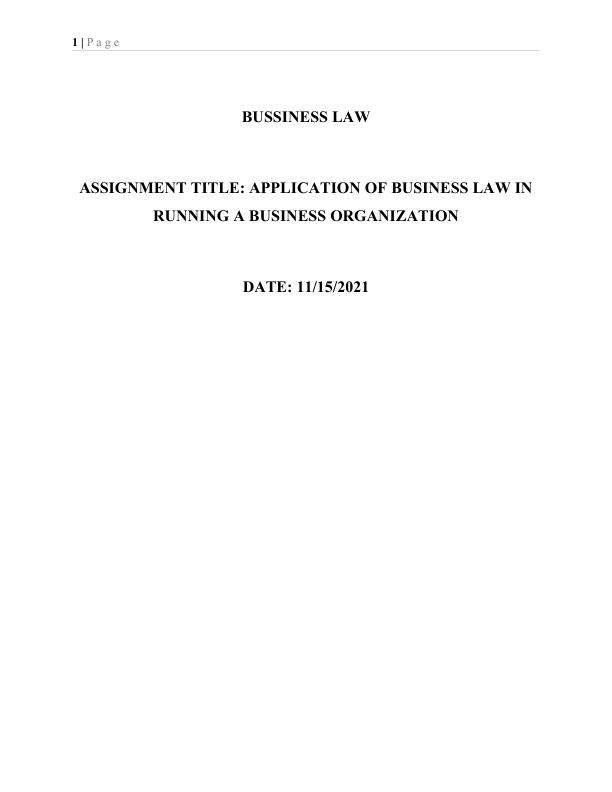
2 | P a g e
Contents
PART A...........................................................................................................................................7
DIFFERENT SOURCES OF LAW.................................................................................................7
CONSTITUTIONAL LAW.........................................................................................................7
STATUTORY LAW...................................................................................................................7
JUDICIAL LAW.........................................................................................................................7
THE ROLE OF GOVERNMENT IN LAW MAKING..................................................................8
LEGISLATURE..........................................................................................................................8
EXECUTIVE...............................................................................................................................8
JUDICIARY................................................................................................................................8
THE APPLICATION OF STATUTORY AND COMMON LAW IN THE JUSTICE COURTS. 9
EFFECTIVENESS OF THE LEGAL SYSTEM IN TERMS OF RECENT REFORMS AND
DEVELOPMENTS........................................................................................................................10
IMPACT OF THE 2020 TAX POLICY ON CARREFOUR....................................................10
VAUE ADDED TAX (VAT)................................................................................................10
PAY AS YOU EARN TAX..................................................................................................10
THE POTENTIAL IMPACT THAT EMPLOYMENT AND CONTRACT LAW HAS ON
CARREFOUR...............................................................................................................................11
EMPLOYMENT LAW.............................................................................................................11
CONTRACT LAW....................................................................................................................11
COMPANY LAW.....................................................................................................................12
THE IMPACT ON CARREFOUR THROUGH DIFFERENTIATION BETWEEN
LEGISLATION, REGULATIONS AND STANDARDS............................................................12
LEGISLATION.........................................................................................................................12
REGULATIONS.......................................................................................................................12
STANDARDS...........................................................................................................................13
EVALUATION OF THE LEGAL SYSTEM AND LAW............................................................14
JURY SYSTEM.........................................................................................................................14
THE LEGAL FORMATION OF THE DIFFERENT TYPES OF BUSINESS
ORGANIZATIONS.......................................................................................................................15
SOLE PROPREITORSHIP.......................................................................................................15
1.PICK A NAME...................................................................................................................15
2.ACQUIRE PERMITS AND LICENSES...........................................................................15
Contents
PART A...........................................................................................................................................7
DIFFERENT SOURCES OF LAW.................................................................................................7
CONSTITUTIONAL LAW.........................................................................................................7
STATUTORY LAW...................................................................................................................7
JUDICIAL LAW.........................................................................................................................7
THE ROLE OF GOVERNMENT IN LAW MAKING..................................................................8
LEGISLATURE..........................................................................................................................8
EXECUTIVE...............................................................................................................................8
JUDICIARY................................................................................................................................8
THE APPLICATION OF STATUTORY AND COMMON LAW IN THE JUSTICE COURTS. 9
EFFECTIVENESS OF THE LEGAL SYSTEM IN TERMS OF RECENT REFORMS AND
DEVELOPMENTS........................................................................................................................10
IMPACT OF THE 2020 TAX POLICY ON CARREFOUR....................................................10
VAUE ADDED TAX (VAT)................................................................................................10
PAY AS YOU EARN TAX..................................................................................................10
THE POTENTIAL IMPACT THAT EMPLOYMENT AND CONTRACT LAW HAS ON
CARREFOUR...............................................................................................................................11
EMPLOYMENT LAW.............................................................................................................11
CONTRACT LAW....................................................................................................................11
COMPANY LAW.....................................................................................................................12
THE IMPACT ON CARREFOUR THROUGH DIFFERENTIATION BETWEEN
LEGISLATION, REGULATIONS AND STANDARDS............................................................12
LEGISLATION.........................................................................................................................12
REGULATIONS.......................................................................................................................12
STANDARDS...........................................................................................................................13
EVALUATION OF THE LEGAL SYSTEM AND LAW............................................................14
JURY SYSTEM.........................................................................................................................14
THE LEGAL FORMATION OF THE DIFFERENT TYPES OF BUSINESS
ORGANIZATIONS.......................................................................................................................15
SOLE PROPREITORSHIP.......................................................................................................15
1.PICK A NAME...................................................................................................................15
2.ACQUIRE PERMITS AND LICENSES...........................................................................15
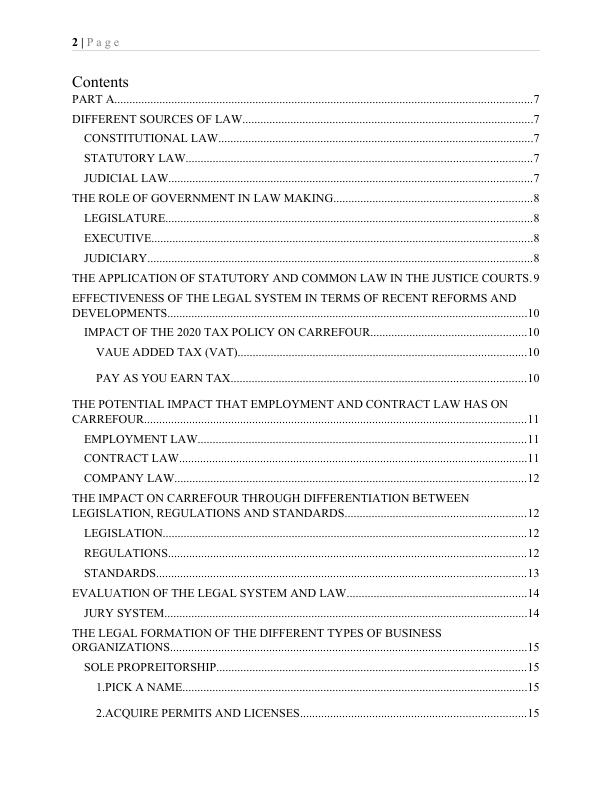
3 | P a g e
3.ESTABLISH SEPARATE FINANCES.............................................................................16
4.REPORTING TAXES........................................................................................................16
PARTNERSHIPS......................................................................................................................16
1.CHOOSE A PARTNERSHIP NAME................................................................................16
2.REGISTERING THE FICTITIOUS NAME......................................................................16
3.CREATING AND SIGNING THE PARTNERSHIP AGREEMENT...............................16
4.WORKING WITH REGULATIONS AND TAX REQUIREMENTS..............................17
5.INSURANCE.....................................................................................................................17
CORPORATION.......................................................................................................................17
1.HIRE A TRANSACTIONAL ATTORNEY......................................................................18
2.APPOINT A REGISTERED AGENT AND FILE THE ARTICLES OF
INCORPORATION...............................................................................................................18
3.CREATE THE CORPORATE BYLAWS AND APPOINT DIRECTORS.......................18
4.ISSUE STOCK...................................................................................................................18
5.FILE DOCUMENTS REQUIRED BY SECRETARY OF STATE..................................18
6.FILE ANY NECESSARY KRA FORMS..........................................................................18
LIMITED LIABILITY COMPANY (LLC)..............................................................................19
1.PICK A NAME...................................................................................................................19
2.CREATE THE ARTICLES OF ORGANIZATION..........................................................19
3.SELECT A REGISTERED AGENT..................................................................................19
4.FILE WITH THE SECRETARY OF STATE....................................................................19
5. FEE....................................................................................................................................19
6.PUBLICATION REQUIREMENTS..................................................................................20
7.OBTAIN AN LLC CERTIFICATE...................................................................................20
8.REGISTER FOR AN EIN..................................................................................................20
9.GET PERMITS OF LICENSES.........................................................................................20
3.ESTABLISH SEPARATE FINANCES.............................................................................16
4.REPORTING TAXES........................................................................................................16
PARTNERSHIPS......................................................................................................................16
1.CHOOSE A PARTNERSHIP NAME................................................................................16
2.REGISTERING THE FICTITIOUS NAME......................................................................16
3.CREATING AND SIGNING THE PARTNERSHIP AGREEMENT...............................16
4.WORKING WITH REGULATIONS AND TAX REQUIREMENTS..............................17
5.INSURANCE.....................................................................................................................17
CORPORATION.......................................................................................................................17
1.HIRE A TRANSACTIONAL ATTORNEY......................................................................18
2.APPOINT A REGISTERED AGENT AND FILE THE ARTICLES OF
INCORPORATION...............................................................................................................18
3.CREATE THE CORPORATE BYLAWS AND APPOINT DIRECTORS.......................18
4.ISSUE STOCK...................................................................................................................18
5.FILE DOCUMENTS REQUIRED BY SECRETARY OF STATE..................................18
6.FILE ANY NECESSARY KRA FORMS..........................................................................18
LIMITED LIABILITY COMPANY (LLC)..............................................................................19
1.PICK A NAME...................................................................................................................19
2.CREATE THE ARTICLES OF ORGANIZATION..........................................................19
3.SELECT A REGISTERED AGENT..................................................................................19
4.FILE WITH THE SECRETARY OF STATE....................................................................19
5. FEE....................................................................................................................................19
6.PUBLICATION REQUIREMENTS..................................................................................20
7.OBTAIN AN LLC CERTIFICATE...................................................................................20
8.REGISTER FOR AN EIN..................................................................................................20
9.GET PERMITS OF LICENSES.........................................................................................20
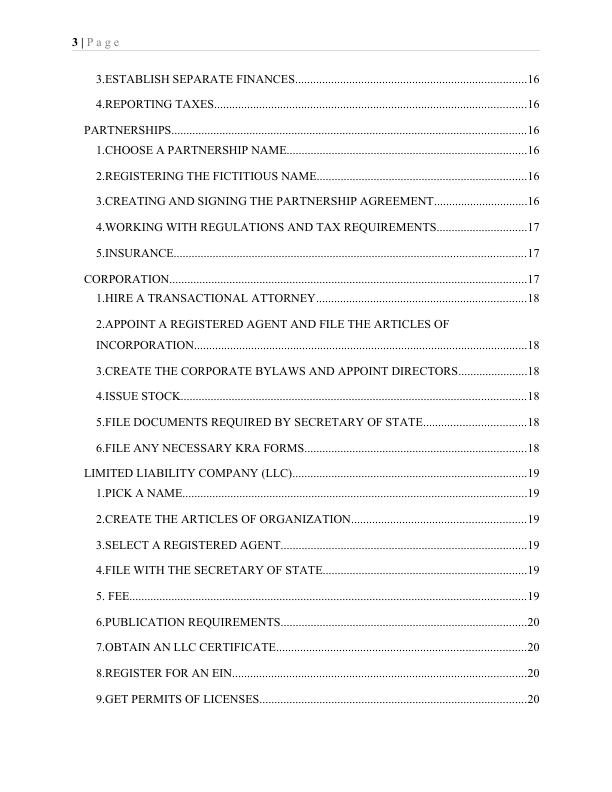
4 | P a g e
10. CREATE AN OPERATING AGREEMENT..................................................................20
THE ADVANTAGES AND DISADVANTAGES OF THE FORMATION OF DIFFERENT
TYPES OF BUSINESS ORGANISATIONS................................................................................20
SOLE PROPRIETORSHIP.......................................................................................................20
PARTNERSHIPS......................................................................................................................21
CORPORATION.......................................................................................................................21
LIMITED LIABILITY COMPANY.........................................................................................21
HOW BUSINESS ORGANISATIONS ARE MANAGAED AND FUNDED............................22
SOURCES OF FUNDING........................................................................................................22
PERSONAL CAPITAL.........................................................................................................22
CROWD FUNDING.............................................................................................................22
ANGEL INVESTORS...........................................................................................................22
BANK LOANS......................................................................................................................22
MANAGEMENT......................................................................................................................23
SOLE PROPRIETORSHIP...................................................................................................23
PARTNERSHIPS..................................................................................................................23
CORPORATIONS.................................................................................................................23
LIMITED LIABILITY COMPANY.....................................................................................23
METHODS FOR RESOLVING CONFLICTS AND DISPUTES...............................................24
MEDIATION.............................................................................................................................24
ARBITRATION........................................................................................................................24
LITIGATION............................................................................................................................24
NEGOTIATION........................................................................................................................24
SOURCES OF LEGAL ADVICE.................................................................................................25
FEDERAL TRADE COMMISSION........................................................................................25
KENYA REVENUE AUTHORITY.........................................................................................25
SCORE......................................................................................................................................25
TRADE ASSOCIATIONS........................................................................................................25
PRO BONO SERVICES...........................................................................................................26
REFERENCES..............................................................................................................................27
10. CREATE AN OPERATING AGREEMENT..................................................................20
THE ADVANTAGES AND DISADVANTAGES OF THE FORMATION OF DIFFERENT
TYPES OF BUSINESS ORGANISATIONS................................................................................20
SOLE PROPRIETORSHIP.......................................................................................................20
PARTNERSHIPS......................................................................................................................21
CORPORATION.......................................................................................................................21
LIMITED LIABILITY COMPANY.........................................................................................21
HOW BUSINESS ORGANISATIONS ARE MANAGAED AND FUNDED............................22
SOURCES OF FUNDING........................................................................................................22
PERSONAL CAPITAL.........................................................................................................22
CROWD FUNDING.............................................................................................................22
ANGEL INVESTORS...........................................................................................................22
BANK LOANS......................................................................................................................22
MANAGEMENT......................................................................................................................23
SOLE PROPRIETORSHIP...................................................................................................23
PARTNERSHIPS..................................................................................................................23
CORPORATIONS.................................................................................................................23
LIMITED LIABILITY COMPANY.....................................................................................23
METHODS FOR RESOLVING CONFLICTS AND DISPUTES...............................................24
MEDIATION.............................................................................................................................24
ARBITRATION........................................................................................................................24
LITIGATION............................................................................................................................24
NEGOTIATION........................................................................................................................24
SOURCES OF LEGAL ADVICE.................................................................................................25
FEDERAL TRADE COMMISSION........................................................................................25
KENYA REVENUE AUTHORITY.........................................................................................25
SCORE......................................................................................................................................25
TRADE ASSOCIATIONS........................................................................................................25
PRO BONO SERVICES...........................................................................................................26
REFERENCES..............................................................................................................................27
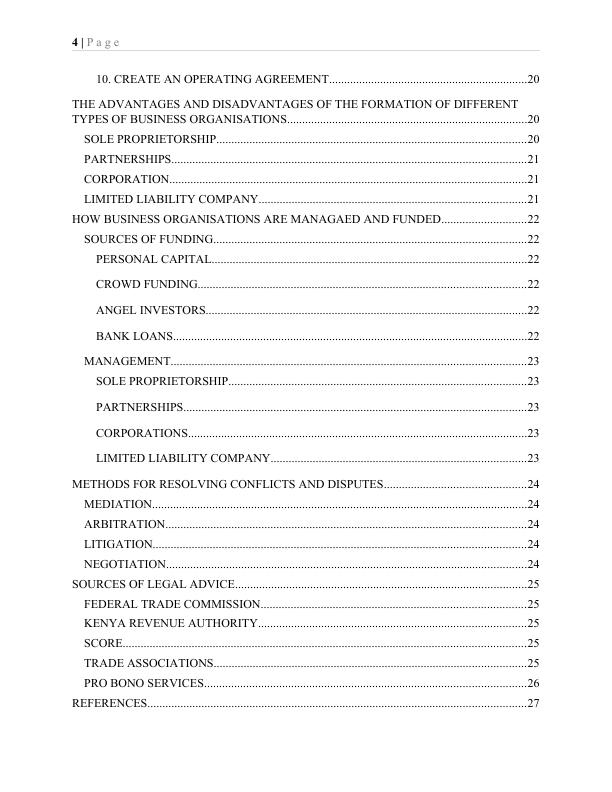
5 | P a g e
PART A
DIFFERENT SOURCES OF LAW
Law is defined as a set of rules and regulations set by a certain authority in a community or
organization and the people are subject to penalty if violated. This can be a type of policy or law
that is acknowledged and imposed by court. For instance, a person who committed an act of theft
is subject to imprisonment if guilty (Dictionary.com, 2021). Sources of law also known as
sovereign are where the laws are originating from. Carrefour needs to make sure that it’s
business operations are in line with the Kenyan law.
The three main sources of law include;
CONSTITUTIONAL LAW
Constitutional law is a set of principles, rules and practices of a nation or community, which
determine the authority and obligations of the government. These obligations include making
sure that people’s rights and needs are addressed. An example of constitutional law is that the
employees of Carrefour should have the right to freedom of speech (Shugart, 1999).
STATUTORY LAW
Statutory law is inferior to constitutional law. The constitution is directed to government conduct
whereas the statutory law is directed to private relations. A statutory law is a written piece of
legislation that is either implemented through written or voting by a legislative branch
(UniversityOfMinnesota, 2015). Some examples of statutory rights relating to Carrefour are, it
should pay a salary to employees that is above the legal minimum wage, awarding employees
with vacations, sick leave etc. (Davis, 2021).
JUDICIAL LAW
Judicial law also known as case law is the source of law a set of legally binding standards of
conduct that are imposed, recognized, and implemented by governing authorities. Common law
PART A
DIFFERENT SOURCES OF LAW
Law is defined as a set of rules and regulations set by a certain authority in a community or
organization and the people are subject to penalty if violated. This can be a type of policy or law
that is acknowledged and imposed by court. For instance, a person who committed an act of theft
is subject to imprisonment if guilty (Dictionary.com, 2021). Sources of law also known as
sovereign are where the laws are originating from. Carrefour needs to make sure that it’s
business operations are in line with the Kenyan law.
The three main sources of law include;
CONSTITUTIONAL LAW
Constitutional law is a set of principles, rules and practices of a nation or community, which
determine the authority and obligations of the government. These obligations include making
sure that people’s rights and needs are addressed. An example of constitutional law is that the
employees of Carrefour should have the right to freedom of speech (Shugart, 1999).
STATUTORY LAW
Statutory law is inferior to constitutional law. The constitution is directed to government conduct
whereas the statutory law is directed to private relations. A statutory law is a written piece of
legislation that is either implemented through written or voting by a legislative branch
(UniversityOfMinnesota, 2015). Some examples of statutory rights relating to Carrefour are, it
should pay a salary to employees that is above the legal minimum wage, awarding employees
with vacations, sick leave etc. (Davis, 2021).
JUDICIAL LAW
Judicial law also known as case law is the source of law a set of legally binding standards of
conduct that are imposed, recognized, and implemented by governing authorities. Common law

6 | P a g e
is under judicial law and is characterized as a set of laws created by judges when they give
decisions on cases (Yourdictionary, 2021). Common law has an effect on how businesses are
operated within a nations jurisdiction. This source of law has an impact on international
businesses. For example, Carrefour being an international business it affects how it is regulated
in terms of tax regulations and compliance (Weaver, 2016).
THE ROLE OF GOVERNMENT IN LAW MAKING
The government is divided into 3 branches, the judiciary, the executive and the legislative. All
the branches are autonomous of one another and their respective duties are defined by the
constitution (Gĩthĩnji, 2021).
The following are the distinct roles of the individual branches of the government;
LEGISLATURE
The legislature is the branch of government in charge of enacting legislation. It is the agency's
job to define the state's will and provide it with legal power and authority. A bill will go through
nine stages before fully becoming a law (Gĩthĩnji, 2021).
EXECUTIVE
The executive is the branch of government in charge of the state's day-to-day operations. The
executive branch carries out and enforces laws (Weaver, 2016).
JUDICIARY
The judiciary is the system of courts that resolves legal disputes and interprets, defends, and
implements the law in legal matters (Weaver, 2016). The judges know how to apply laws when
they decide the cases that come before them. Every legislation requires the correct interpretation
before it can be applied to a specific circumstance. The judges are in charge of this role. (Ghai,
2014).
The following are the nine stages that a bill must go through to become a law;
The bill has to first be drafted by a congress member such as the senate or house of
representatives. The bill must then be submitted after it has been written and presented either in
is under judicial law and is characterized as a set of laws created by judges when they give
decisions on cases (Yourdictionary, 2021). Common law has an effect on how businesses are
operated within a nations jurisdiction. This source of law has an impact on international
businesses. For example, Carrefour being an international business it affects how it is regulated
in terms of tax regulations and compliance (Weaver, 2016).
THE ROLE OF GOVERNMENT IN LAW MAKING
The government is divided into 3 branches, the judiciary, the executive and the legislative. All
the branches are autonomous of one another and their respective duties are defined by the
constitution (Gĩthĩnji, 2021).
The following are the distinct roles of the individual branches of the government;
LEGISLATURE
The legislature is the branch of government in charge of enacting legislation. It is the agency's
job to define the state's will and provide it with legal power and authority. A bill will go through
nine stages before fully becoming a law (Gĩthĩnji, 2021).
EXECUTIVE
The executive is the branch of government in charge of the state's day-to-day operations. The
executive branch carries out and enforces laws (Weaver, 2016).
JUDICIARY
The judiciary is the system of courts that resolves legal disputes and interprets, defends, and
implements the law in legal matters (Weaver, 2016). The judges know how to apply laws when
they decide the cases that come before them. Every legislation requires the correct interpretation
before it can be applied to a specific circumstance. The judges are in charge of this role. (Ghai,
2014).
The following are the nine stages that a bill must go through to become a law;
The bill has to first be drafted by a congress member such as the senate or house of
representatives. The bill must then be submitted after it has been written and presented either in
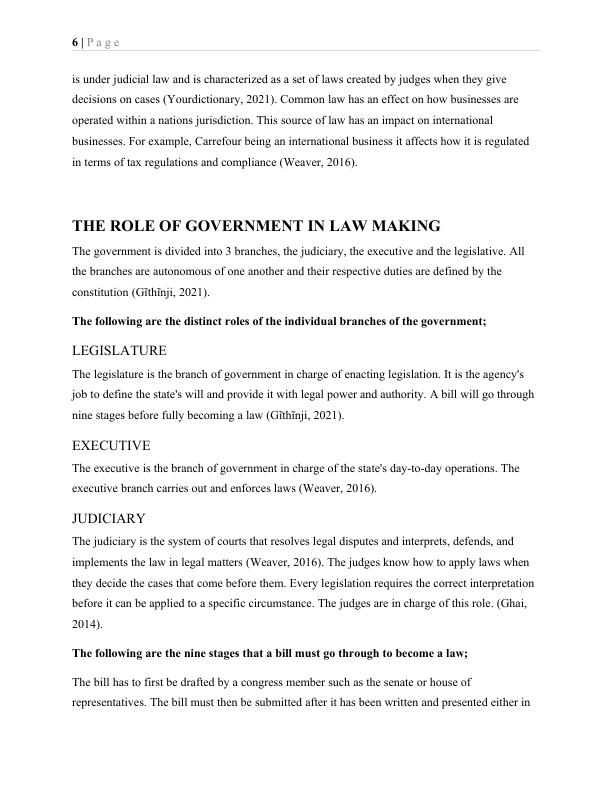
7 | P a g e
the house or senate. The bill is taken to the committee upon proposal. When a bill is sent to a
committee, it is thoroughly studied to evaluate its chances of passing by the entire Congress.
Frequently, committees submit bills to subcommittee for their consideration. When a bill is not
acted on by the committee, it is considered a dead bill. The committee will mark up the bill and
make modifications and amendments before presenting the bill to the floor then there is more
debate and representatives of the whole chamber vote to accept the modifications. The bill is
then referred to another chamber and has the authority to accept it, reject it, ignore it or alter it.
Finally, the bill is then delivered to the president when it has been accepted by the senate and
house. The president can approve the law or decide to decline it (Steinkraus, 2014).
THE APPLICATION OF STATUTORY AND COMMON LAW IN
THE JUSTICE COURTS
The method of determining common law for certain cases commences with research, discovery
of the prior relevant cases, and the collection of statements issued to eventually identify the
applicable common law. Higher court decisions take precedence over lower court decisions and
previous cases. Statutory laws have already been drafted and only need to be applicable to a
particular case. On a daily basis, common law is being developed without any extra cost to state.
Statutory law is created by a government and then structured into law codes. They include all
areas that are governed solely by statutes and also where common law is inapplicable The bill is
forwarded to the President once it has been passed in identical form by both the House and the
Senate. If the law is approved by the President, it is approved and becomes law if not then it is
vetoed. If somehow the President vetoes a bill, Parliament may try to override it. If the bill is
passed by both the Senate and the House with a two-thirds majority, the President's veto is
overturned, and the bill becomes law (Gĩthĩnji, 2021).
the house or senate. The bill is taken to the committee upon proposal. When a bill is sent to a
committee, it is thoroughly studied to evaluate its chances of passing by the entire Congress.
Frequently, committees submit bills to subcommittee for their consideration. When a bill is not
acted on by the committee, it is considered a dead bill. The committee will mark up the bill and
make modifications and amendments before presenting the bill to the floor then there is more
debate and representatives of the whole chamber vote to accept the modifications. The bill is
then referred to another chamber and has the authority to accept it, reject it, ignore it or alter it.
Finally, the bill is then delivered to the president when it has been accepted by the senate and
house. The president can approve the law or decide to decline it (Steinkraus, 2014).
THE APPLICATION OF STATUTORY AND COMMON LAW IN
THE JUSTICE COURTS
The method of determining common law for certain cases commences with research, discovery
of the prior relevant cases, and the collection of statements issued to eventually identify the
applicable common law. Higher court decisions take precedence over lower court decisions and
previous cases. Statutory laws have already been drafted and only need to be applicable to a
particular case. On a daily basis, common law is being developed without any extra cost to state.
Statutory law is created by a government and then structured into law codes. They include all
areas that are governed solely by statutes and also where common law is inapplicable The bill is
forwarded to the President once it has been passed in identical form by both the House and the
Senate. If the law is approved by the President, it is approved and becomes law if not then it is
vetoed. If somehow the President vetoes a bill, Parliament may try to override it. If the bill is
passed by both the Senate and the House with a two-thirds majority, the President's veto is
overturned, and the bill becomes law (Gĩthĩnji, 2021).
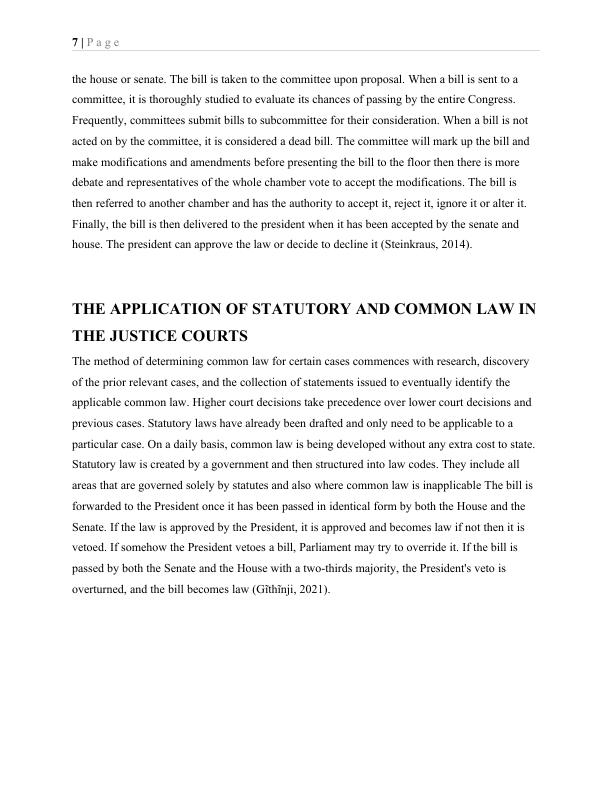
8 | P a g e
EFFECTIVENESS OF THE LEGAL SYSTEM IN TERMS OF
RECENT REFORMS AND DEVELOPMENTS
The following are the different reforms and developments of the 2020 tax policy and the
impact they had on Carrefour;
IMPACT OF THE 2020 TAX POLICY ON CARREFOUR
VAUE ADDED TAX (VAT)
VAT is one of the government's most important sources of revenue. VAT is a consumption tax
that is levied anytime a value is added to eligible products and services at every level of the
supply chain, from manufacture to consumers. It is charged on the consumption of taxable goods
and services provided or imported into Kenya. The tax is collected and submitted to KRA by
registered individuals at specific points in the supply chain (Munandi, 2021).
The change from a 16% to 14% VAT will decrease the taxable value of the products and hence
the VAT amount. Because of this change, Carrefour was able to make their products more
affordable to consumers and also create more promotional material to attract newer customers.
Ultimately it led to a positive correlation from the amount of revenue being generated after as
products became cheaper to the average consumers that were being affected financially by the
pandemic (EYGlobal, 2021).
PAY AS YOU EARN TAX
The Kenyan government had suggested a complete tax exemption for persons making up to
24,000 Kenyan shillings per month. Many Kenyans gained from this as it increased spending
power for those in this income bracket. Pay as you earn rates were reduced from 30 percent to 35
percent. This enabled the government to allocate extra resources to comfort impacted individuals
in the event of a salary decrease. It also benefited Carrefour because it’s employees were more
motivated to continue working even in the middle of a pandemic (Mwangi, 2020).
TURNOVER TAX
Turnover Tax (TOT) is a tax levied on a company's gross sales under section 12(c) of the Income
Tax Act (KRA, 2021). Marking the onset of the Covid-19 outbreak, the Kenyan government
reintroduced new tax policies in an effort to protect taxpayers from the negative impacts of the
EFFECTIVENESS OF THE LEGAL SYSTEM IN TERMS OF
RECENT REFORMS AND DEVELOPMENTS
The following are the different reforms and developments of the 2020 tax policy and the
impact they had on Carrefour;
IMPACT OF THE 2020 TAX POLICY ON CARREFOUR
VAUE ADDED TAX (VAT)
VAT is one of the government's most important sources of revenue. VAT is a consumption tax
that is levied anytime a value is added to eligible products and services at every level of the
supply chain, from manufacture to consumers. It is charged on the consumption of taxable goods
and services provided or imported into Kenya. The tax is collected and submitted to KRA by
registered individuals at specific points in the supply chain (Munandi, 2021).
The change from a 16% to 14% VAT will decrease the taxable value of the products and hence
the VAT amount. Because of this change, Carrefour was able to make their products more
affordable to consumers and also create more promotional material to attract newer customers.
Ultimately it led to a positive correlation from the amount of revenue being generated after as
products became cheaper to the average consumers that were being affected financially by the
pandemic (EYGlobal, 2021).
PAY AS YOU EARN TAX
The Kenyan government had suggested a complete tax exemption for persons making up to
24,000 Kenyan shillings per month. Many Kenyans gained from this as it increased spending
power for those in this income bracket. Pay as you earn rates were reduced from 30 percent to 35
percent. This enabled the government to allocate extra resources to comfort impacted individuals
in the event of a salary decrease. It also benefited Carrefour because it’s employees were more
motivated to continue working even in the middle of a pandemic (Mwangi, 2020).
TURNOVER TAX
Turnover Tax (TOT) is a tax levied on a company's gross sales under section 12(c) of the Income
Tax Act (KRA, 2021). Marking the onset of the Covid-19 outbreak, the Kenyan government
reintroduced new tax policies in an effort to protect taxpayers from the negative impacts of the
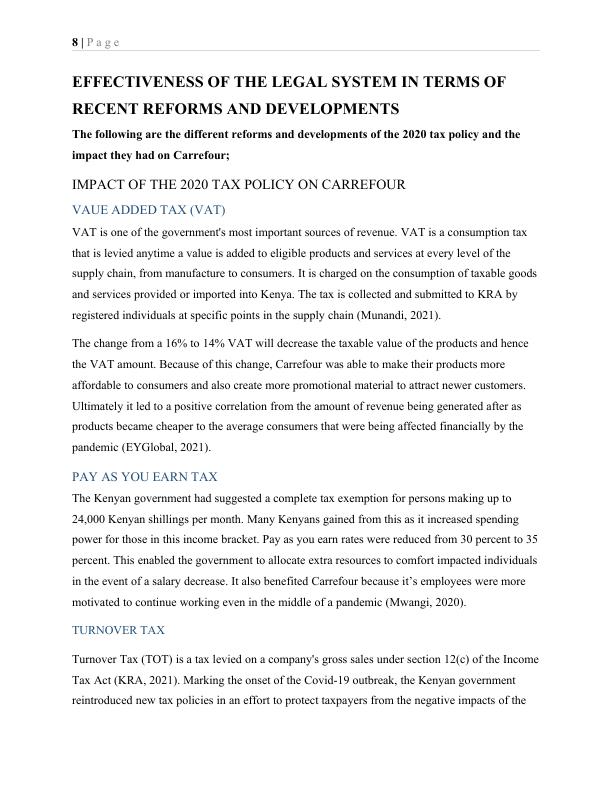
End of preview
Want to access all the pages? Upload your documents or become a member.
Related Documents
Accounting Principles in Carrefour Supermarketlg...
|31
|6808
|254
Legal Solutions for Business Organizationslg...
|11
|2960
|26
2017 Tax Computation Worksheet - Form 1040lg...
|2
|686
|107
Essay on Technical Communicationlg...
|35
|10568
|82
Complex Broking Solution for Mortgage Borrowinglg...
|30
|7551
|373
Chiedza Antonatte Marime Assignment 2022lg...
|20
|536
|29
